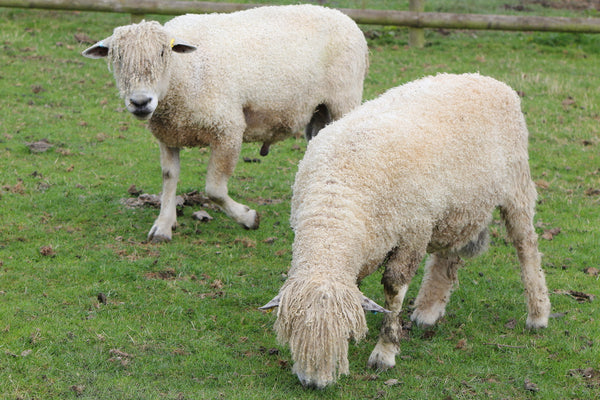Know Your Fiber: Cotswold Wool
Posted on April 01 2022

Look at those fluffy forelocks! Cotswold sheep are perhaps the most emo-looking sheep out there. With their lustrous locks and ever-so-slightly golden wool, this rare sheep breed is a treat for fiber artists. The first Cotswold sheep likely came to North American in the early 1800s, but they have a much more ancient history in England.
Just as their name indicates, Cotswold sheep are from the Cotswolds of England. For many years, linguists assumed that Cotswolds meant hills with sheepcotes (a covered shelter for sheep). However, modern linguists have traced the word Cotswold to Cuda’s Land, an early mother-goddess of the region. The Cotswolds have a rich history of early human settlement, and sheep have been there since the Neolithic era. Archaeological digs in the Cotswolds have unearthed tools, such as awls, made of sheep bone. It is not much of a stretch to assume that people in that period also used sheep for meat and wool.
Native short-wooled sheep were raised in the Cotswolds for millennia before the Romans arrived with their long-wooled sheep around 55 BCE. Both Roman armies and Roman settlers brought their sheep along with them, and these long wooled sheep with breed with the local sheep. Most U.K. sheep breeds today are descended from these mixes, and Cotswold sheep are no exception. It is likely that the popular and sought-after wool of Cotswold sheep came from these pairings, but it was the coloring of the wool that impressed the wool traders of previous centuries.
During the Medieval period, the Cotswolds became a particularly prosperous area of England known for its Cotswold Lions. Rather than feline, these lions were the ovine Cotswold sheep, known and coveted throughout Europe for their lustrous locks with creamy, golden undertones. The wool from these sheep was highly valued, and huge flocks were raised on the Cistercian abbeys and lands on the Cotswolds. The Cistercian order was already known throughout Europe for their wool production; they were remarkably driven and skilled, and wool from their flocks created an enormous amount of wealth for both their order and the Church. Weavers from Florence valued wool from the Cotswold Lions and used it to weave cloth of gold – a fine cloth with gold threads woven into it. Some have speculated that wool from the Cotswold Lions may also have been used by Cistercian abbey workers to create cloth of gold, although that tale may be more legend than fact.
The English Reformation brought with is the dissolution of Catholic abbeys. The wealth that the Catholic Church received from English wool came to an abrupt stop as both lands and livestock were distributed to English nobility. The sheep, being sheep, could not have cared less for politics and wars, and continued as they always had. The farmers of the Cotswolds continued to raise them for their valuable wool, and there was little change to the breed until the early 1800s. During that period, many English sheep breeds underwent improvement by being deliberately crossed with other breeds of sheep to improve their meat and/or wool. Many sheep underwent improvement specifically to make them better dual-breeds – that is, sheep that could produce better quality mutton as well as wool. Breeders of the period improved the Cotswold sheep by crossing them with English Leicesters. Improvement to Cotswold sheep was not only happening in England, either. Christopher Dunn, the first recorded Cotswold breeder in the US, also worked to improve the breed. Dunn’s improved Cotswolds were so highly thought of that English breeders purchased many of his Cotswold sheep to further improve their own.
By the early 1900s, Cotswolds remained highly thought of, although their main value was to crossbreed them with other sheep to help improve the staple length of other breeds’ wool. However, as with many other English breeds of sheep, war and an increased interest in farming breeds of sheep bred for finer and more wool meant that Cotswolds quickly became endangered. By the end of WWI there was a significant reduction of Cotswold flocks, and by the end of WWII only a few flocks remained.
Fortunately for the Cotswold sheep, the revival of hand-spinning that began in the 1970s created a renewed appreciation of their wool, as well as the wool of other endangered breeds. This, coupled with the interest in using meat from heritage livestock by restaurants, has meant that the Cotswold sheep have seen an increase in the number of flocks kept. Although still threatened, this breed’s chance of survival has become much improved.
Easily identified by their heavy forelocks that are traditionally left alone during shearing, these white-faced and long-legged sheep are just plain cute. Their wool, however, is amazing. Many Cotswold sheep still have that wonderful wool that has the light, golden undertone so valued by medieval wool traders. Additionally, the luster of the wool is amazing, and dyed Cotswold wool is comparable to mohair in its ability to glow with color. Cotswold is frequently sold in locks rather than roving, as many spinners and crafters enjoy using the whole locks in their work or like to blend it with other fibers to take advantage of its long staple length and sheen. Cotswold is a thicker wool, with a fiber width of around 32-38 microns, which is also a part of the reason that spinners like to blend Cotswold wool with other fibers. The staple length on Cotswold wool is also quite impressive, typically coming in at around 6-8 inches.
Ready to do your part to save this rare breed? Check out our Cotswold wool here are Northwest Yarns!


Follow US